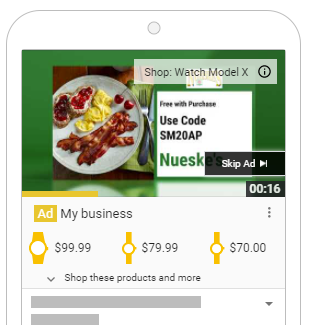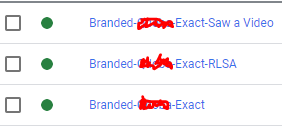20 Jan How to Use YouTube Ads to Support SEM: A Step-by-Step Guide via @jonkagan
YouTube Ads.
You know you need them.
Yet, you may be struggling to determine if they provide tangible value and wonder whether there is even a way to track it.
More often than not, marketers lack the funds or resources for some fancy multi-touch/impression attribution approach.
And without that proof of how it impacts your bottom line – if they don’t convert directly – you can’t get the resources to support the effort.
So, let’s talk about the “poor man’s” approach to YouTube down-funnel impact.
How Can YouTube Ads Support Your SEM Efforts?
If you aren’t already on YouTube, you should be if for no other reason than this:
From January (pre-pandemic) to April (early pandemic), time spent on YouTube by consumers rose 26%.
That means there is more opportunity to get your ad ingrained into a viewer’s head.
Let’s be clear: aside from YouTube Shopping ads (a.k.a., TrueView for Shopping), last-click conversions/sales are incredibly low and likely not going to turn you a profit.
If you think they will, you’re as optimistic as me believing each year that the New York Jets will win the Super Bowl in my lifetime.
They will not. Just accept it.
But that doesn’t mean YouTube Ads aren’t beneficial to your brand approach in other ways. You just need to find a way to confirm it.


YouTube Ads aren’t a novelty to SEM programs anymore. They’re now a standard.
Not to mention it’s easier to get your ads on YouTube now than ever before.
Even if you don’t have a video, you can utilize the YouTube Video Builder (you must get on the beta list to do so), and use the templates and cheesy music to make your ad in a matter of minutes.
(You will quickly discover that there are more shades of red than you ever knew existed.)


You’re probably saying, how exactly do YouTube ads support my SEM efforts if it isn’t driving me direct conversions?
Simple: You’re laying the groundwork for brand awareness for new consumers to hit your brand keyword over your more expensive non-brand keywords.
In addition, you are aiding a viewer in connecting your brand to a specific vertical with the reinforcement of a non-brand keyword.
Inversely, SEM can also give you a non-scientific but insightful baseline about how impactful your video ads are on consumers.
But we’ll get to that part later.
Now that the expectation of getting a direct conversion has been crushed, let’s discuss how you should set up, manage, and attribute your ads on YouTube and then track it with SEM.
The Objective
Drive awareness (for either new or repeat) visitors.
Your trickiest job is to make a captivating and engaging video creative.
Once that’s done, your primary focus is to get a consumer to watch your video ad in full and/or (secondary focus) to proceed directly to your site from the video.
And to do all of this for as low a cost as possible.
Nothing more.
Pro Tip: Focus on creating 30-second (not 15-second) videos, and nothing over 35 seconds. Deliver the primary message in the first 5-7 seconds.
This way, you’ve relayed the message before a consumer can skip, but given them the leeway to skip it if they are less qualified.
Targeting & YouTube Setup
The targeting for a YouTube effort supporting your SEM initiative can vary.
It can waffle in size depending on your consumer audience, current brand recognition, marketplace demand, etc.
What I recommend is to segment in order to have the cleanest data possible.
You can segment it in a variety of ways, such as repeat vs. first-time visitors, topics, audiences, devices, demographics, etc.
But to get the best understanding of the down-funnel impact, I like to break it out in a style like this:
- Remarketing: Plain and simple, those who have been to the site before.
- Prospecting – First-time View: Never been to the site before, never seen the video before. From here, this gets subdivided by additional targets such as demo’s, topics, audiences, etc.
- Prospecting – Repeat View: Never been to the site, completed one video view (note: frequency caps help redirect lists here).
From here, this gets subdivided by additional targets such as demos, topics, audiences, etc.


Pro Tip: Ultimately, each part of the setup becomes a remarketing list, which is vitally important to your strategy later. So, once you make a target and start getting data, create an audience list to collect the data from that segment.


At this point, you will launch your YouTube ads and allow the audience lists to populate.
Once this happens, you will proceed on to the SEM side of the effort.
The SEM Phase
Don’t ignore your YouTube ads, but once their performance is fine-tuned this can take up less of your immediate focus.
In your SEM program, you can set this up at the campaign or ad group level (I prefer the campaign level because I like more budget control, but ad group is also fine) and break it out the way I noted above.


I get a bit stubborn here, so take my strategy as much as you wish. In any remarketing-based scenario (because that is ultimately what this is), I lean heavily on a max click strategy.
Why?
Because if they are searching for you/your category, after having completed watching your video ad, then they have prequalified themselves.
Therefore, you can focus on capturing as much of that traffic as possible (as opposed to a TCPA scenario, for example).
To make it a little less scary, throw on a Max CPC cap on the bid strategy.
Do not be afraid to use short-tail keywords (remember, they are already prequalified to some degree).
While you set the bid strategy, make sure your messaging and extensions match the messaging of the video.
This provides consistent messaging and user experience from a multi-touch scenario.
Pro Tip: Make sure you use negative audience lists to funnel the traffic so that only those who saw the video and haven’t visited the site before are separate from the general prospecting audience.
The Output: Measuring Down-Funnel Impact of YouTube Ads on SEM
Now you will see if your YouTube effort is a bust, or if it is solidly sending traffic down funnel, benefitting your SEM effort.
In the SEM groupings, the audience that was previously exposed to your video will populate with traffic. This indicates the down funnel shift.


Do not expect the “Saw a Video” audience to be your top performer.
In general, it should perform more efficiently than your general prospecting audience.
While SEM won’t capture all the demand generated by YouTube, it will definitely pick up a portion of it, giving you more control over the consumer experience of the ads they see prior to converting.
This strategy also gives marketers a better understanding of how video creative impacts onsite engagement in a more directly attributable fashion.
More Resources:
- A Complete Guide to PPC Ad Formats
- 10 Important PPC Trends to Watch in 2021
- PPC 101: A Complete Guide to PPC Marketing Basics
Image Credits
All screenshots taken by author, January 2021
Sorry, the comment form is closed at this time.